10/01/2022
Citations:
Federici, Silvia. Caliban and the Witch: Women, the Body and Primitive Accumulation. Buy here: https://amzn.to/3Fh4bR0
As an Amazon Associate, I earn from qualifying purchases.
Chapter 1. All the World Needs a Jolt: Social Movements & Political Crisis in Medieval Europe
All the world must suffer a big jolt. There will be such a game that the ungodly will be thrown off their seats, and the downtrodden will rise.
Thomas Munster
Open Denial of the False Belief of the Godless World on the Testimony of the Gospel of Luke, Presented to Miserable and Pitiful Christendom in Memory of Its Error. 1524
There is no denying that, after centuries of struggle, exploitation does continue to exist. Only its form has changed. The surplus labor extracted here and there by the masters of today’s world is not smaller in proportion to the total amount of labor than the surplus extracted long ago. But the change in the conditions of exploitation is not in my view negligible…. What is important is the history, the striving for liberation.
Pierre Dockes
Medieval Slavery and Liberation. 1982
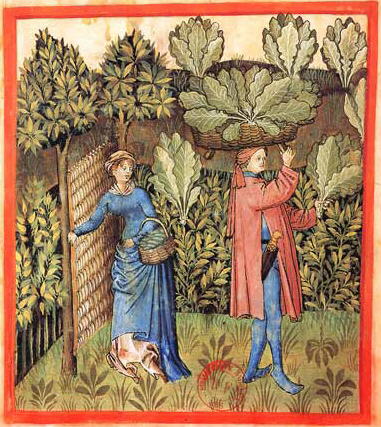
“For the knights and eke the clerk
Unknown
Live by him who does the work”.
Sounds familiar? Of course! But this poem was written during the medieval period in Europe that lasted from the 5th to 15th century. The exact date of the poem was not noted down. So we don’t even know the name of the poet! But being as bright as a witch always is, I can simply use my power to assume that it was written by the one “who does the work”. That was the time of feudalism and the poet must have been either a serf or a peasant who talked too much for his or her own good.
So what exactly was feudalism? How did it all begin? When and for what reason did it occur? What is what? Hang on! I am going to explain.
As with most things in the West, we begin our story with the Roman Empire. It always goes back to the Roman Empire.
By the end of the 5th century, the grand Roman empire had fallen to the barbarians. Everywhere Roman civilization was under attack. Constant wars disrupted trade. Merchants feared pirates on sea and outlaws on land. Without the empire, cities as centers of administration collapsed. With little trade, towns were no longer centers for business. The city dwellers left their decaying cities and settled into the countryside. They started growing their own food. The population of Europe became overwhelmingly rural. And that’s when a new economic and social system emerged in medieval Europe in which nobility held lands from the crown in exchange for protection. The control of land was the key to feudalism. At the heart of the feudal system was an agreement between a lord and a vassal. A vassal was a person who received land from a lord.
The personal bond of loyalty that tied a vassal to a lord were the key to the feudal system. The oath sworn between them was the equivalent of today’s written contract. But the feudal game was way more complicated than you’d imagine! The piece of any land that a vassal received from his lord, he re-divided it. The piece of land was called a fief. The word “Feudalism” is from the Latin word Fuden- meaning a fief.
A fief was both property and a set of rights granted to a vassal in fealty (literally in fee) to a lord. These rights included the right to live on the land. The right to own your own family (which slaves had not previously had). The right to pass down land to one’s descendants. The rights of a vassal were enshrined in the class relation of serfdom.
Quite complicated. Isn’t it! Let me solve it to you by showing you my cauldron. Here! Look! You can see a pyramid in it. Yes! The feudal society was exactly like a pyramid. At the bottom were many serfs, each with a small fief. Above them were their lords, who held larger fiefs. And all over all was the king.
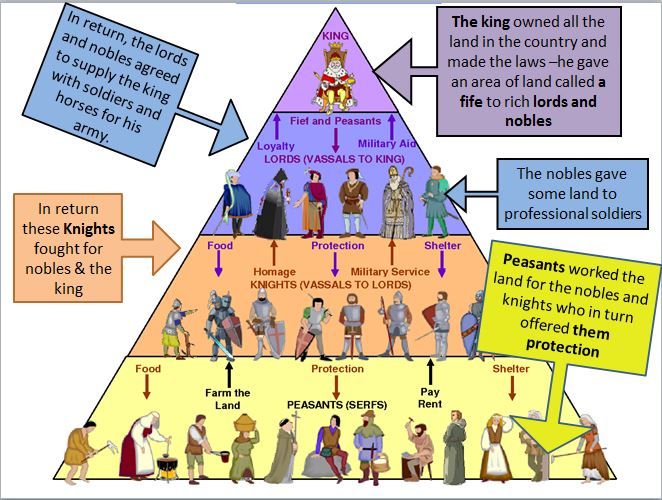
As the great Roman Empire rested upon the slave labor, feudalism rested upon the labor of the serfs. Serfs were not the same as slaves. Serfs technically had rights, which slaves did not have. The society had evolved into a new social system and so had the social relations with it. Most of the fief that was also the farm land, was divided into areas known as “manors”. A manor was made up of several acres of arable lands on which the serfs, which were the tenants of the lords, worked day and night. In return for a fief, serfs were bonded to their lord: their persons, possessions, and lives were controlled by the laws of the manor. It is true that the conditions of the serfs and peasant was far from ideal, but it was still better than slavery. With the property given to them, “it gave the serfs direct access to the means of their reproduction.” They used the land to not only meet their lords needs & desires, but also to meet their own needs. Even while struggling against their lords, they still had the means to survive. And, kicking serfs off of their land was uncommon because feudalism was largely a closed economy limited to individual localities, which means it was hard to find replacement labor.
Serfdom too, was divided into groups and communities. There were bounded peasants, free peasants, male peasants and female peasants. Unsurprisingly, women were treated as second class citizens when it came to owning property or holding political offices. But, there was significantly less division of labor amongst the sexes. Unlike today, there was little separation between producing goods and reproducing the work-force. Because serfdom was largely subsistence living “all work contributed to the family’s sustenance.” Today, housework is significantly devalued and not considered real work even though housework is the literal reproduction of the species. Don’t even get me started with these capitalist pigs!
Most of what they produced, whether food, goods, or services was owed to the Lord.
You might think they needed money every day to buy things? But, you’d be wrong. In feudal times, almost nothing was bought. Feudal life went on with very little use of money. It was an economy of consumption, in which each manorial village was practically self-sufficient. If someone asks you what you paid for a new coat, the chances are a hundred to one that you will give an answer in dollars and cents. But if that same question were asked you in the Middle Ages, the chances are equally as good that you would have answered, “I made it myself”. The serfs grew their own food, and with their own hands made whatever furniture they needed. The lords of the manors attached to their households those serfs who were good craftsmen to make the things they needed. The manorial village was a closed economic system, where valuable goods like food, weapons, tools, furniture, etc, did not travel far in the period between its origin and its end. It made things it required and consumed them.
The Commons
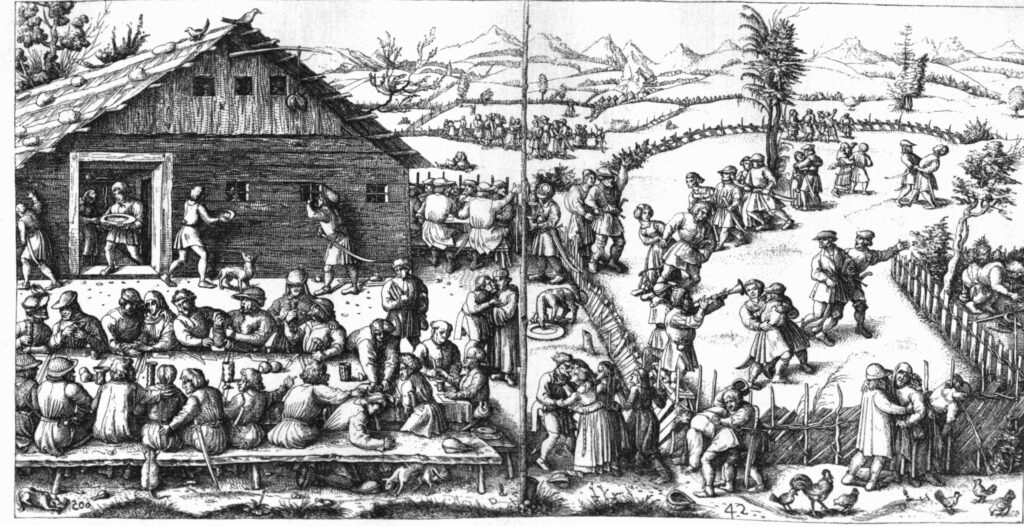
Essential to feudal life for the peasants was their use of the commons. The commons were territories that belonged to no one. Open fields, wild pastures, deep forests, and more were common areas available to anyone. Peasants supplemented their subsistence living with berries, nuts, fire wood, rocks from quarries all available in the commons. They supplemented their diets by hunting and fishing from small ponds. Many peasants collectively agreed to an open-fields system of agriculture or “an arrangement by which villagers owned non-contiguous strips of land in a non-hedged fielded.” (69) Peasants choose a strip of land in the commons to farm in additional to the farming they did on the land provided to them by their Lord. Peasants used the commons so their livestock could graze.
The commons were also an important space for peasant social gatherings and celebrations. “Beside encouraging collective decision-making and work cooperation, the commons were the material foundation upon which peasant solidarity and sociality could thrive. All the festivals, games, and gatherings of the peasants community were held in the commons.” (71) They were essential to a harmonious peasant community and for women, like myself, were the centers of social life. It was the place where us women “convened, exchanged news, took advice, and where a women’s viewpoint on communal events, autonomous from that of men, could form.” (71-72) We had less access to land and other rights, so the commons gave us a little extra autonomy, not just from the Lords, but also the Patriarchy.
In the next chapter, we’ll learn how the enclosure of the commons destroyed much solidarity amongst the peasants and particularly how it effected us women.
Feudal Resistance
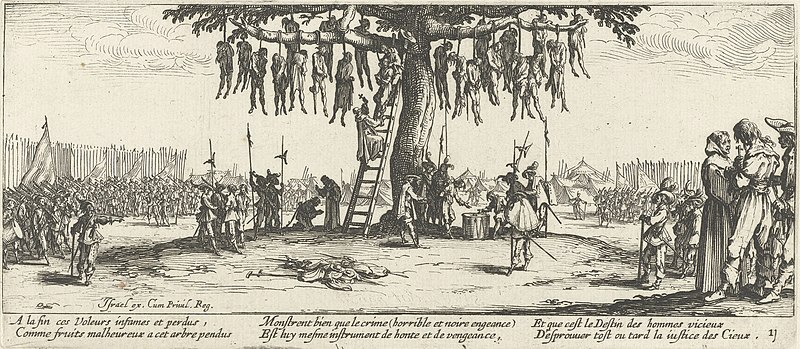
Class relations were certainly not smooth in feudalism. The era is marked with endless peasant revolts and uprisings. Because serfdom was a system of exploitation. All the peasants, whether free or not, were tenants on the lord’s manor. They paid dearly for the right to live and grow crops on the lord’s land.
By the 14th century, peasant revolts against the aristocracy became endemic and frequently armed. According to Federici, “The main objective of the serfs was to keep hold of their surplus-value and products and broaden the sphere of their economic and juridical rights.” (26) Not only were there endless taxes on peasants—death taxes, inheritance taxes, marriage taxes, church taxes, kitchen taxes and taxes cause we fucking said so—peasants were also expected to give a significant portion of their time to the needs of their lord. Working the lord’s crops, fulfilling the lord’s military needs or ambitions, and so on and so forth. Between the taxes & labor, Federici says, “revealed all the arbitrariness of feudal power. Thus, they were strenuously resisted.” (27)
So you see! Life on the manor was really harsh! There were times when the peasants even starved. They worked their fingers to the bone but could not save any surplus for themselves. Surplus was an extra amount of the goods that they produced with their labor. The tension started when the peasants started getting enough tricks of the trade and they became fast in production. They started producing more which they wanted to keep for themselves, and that’s what the lords didn’t let them do.
And that’s when the world needed a jolt!
And it started, viva la resistance! There were many tactics serfs used as forms of resistance before taking up arms and fighting. “They stopped showing up to work on time They’d let the crops spoil, or worked sloppily, taking unnecessarily long breaks, and worst of all, insubordination.” What the lords called, “foot-dragging, false compliance, desertion, pilfering, poaching” were the everyday forms of resistance against the feudal system.
These are just a small list of revolts throughout the High Middle Ages.
- There was the peasant revolt in Maritime Flanders from 1323-1328.
- The Tuchins, a movement of bandits in Southern France made up of urban artisans and rural peasants that lasted from 1378-1384.
- The English Peasant Revolt of 1381.
- In 1335, in Ghent (which is here) weavers attempted a worker’s democracy that suppressed all authorities except those who performed manual labor. They tried again in 1378 and this time it lasted in 1382.
- The Ciompi revolt occurred in Florence in 1382. Cloth workers there forced the bourgeoisie to give the workers shared control of the government.
- In Catalan (what is modern day Spain), revolts by the Remensas (a particularly brutal form of serfdom in Catalan) lasted from 1472 to 1486 and ended with the King Ferdinand the II of Aragon outlawing the more severe abuses of the Remensa system.
- In Germany, peasant wars began in 1476. Sister Federici says, “This escalated into four bloody rebellions led by the Bundschuch (“Peasant Union”) between 1493 and 1517, and culminating in a full-fledged war that lasted from 1522 to 1525, spreading over four countries.” (46)
Describing this time period, Sister Federici states, “’now is the time’ well illustrates the spirit of the European proletariat at the close of the 14th century.” (45)
Urban Struggles & Commutation
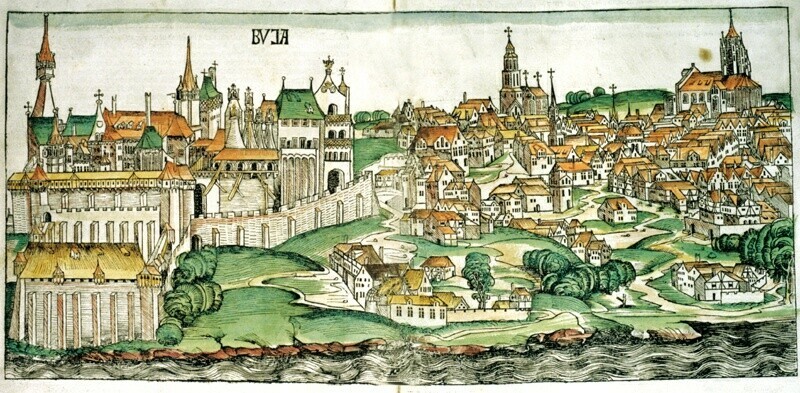
An important change occurred.
The towns had now started emerging again and a new class called “merchants” had come into being that later evolved into a city class. These towns were given certain privileges and charters that allowed them an element of autonomy from the manors and therefore, the politics of the nobility. When the towns emerged, and trade began, money too started thriving. That was the reason why the ‘surplus’ was now more important to the peasants, because they wanted to sell it in the towns. These towns had new hope for the peasants and the serfs. They dreamed of a flight to the town where they too could taste the free air. And many did flee to the town.
The time eventually came when the nobility had no choice but to resolve this conflict. Federici gives a good account of how it happened: commutation. It was when the lord started paying the peasants for their labor services in terms of money, and the peasants started paying for rent the same way. And that, according to Federici “placed the feudal relation on a more contractual basis” (page 24, Chapter 1) That’s how the peasants started turning into wage laborers.
A new economy was now emerging with its own ways of exploitation. It was a tricky and a hidden business. It came under the guise of “freedom” but it was no blessing. Its effects were very destructive! Money economy started creating class difference way wider than history had seen. It snatched whatever land the peasants had from them and turned them into “free workers”. Many of the poorest peasants now had no land of their own.
Women suffered more. As the society was getting into class conflicts, it also started being marked by the gender conflict. Everywhere there was nothing but division! Women lost whatever rights they had before-the right to property and inheritance. Their income was reduced.
By the 13th century, women were leading the migration from the countryside to the renewed urban centers, and by the 15th century they made up a large percentage of the population. Most women still lived in poverty, working low-paying jobs such as maids, hucksters (a person who sells small items, either door-to-door or from a stall or small store), spinsters, and prostitutes. The city did not free women from patriarchal exploitation; yet, it offered them significantly more autonomy than the rural manors controlled by the Lords. Women could live alone, with their children, and some even formed autonomous collectives with other women.
The urban centers also provided more work opportunities for women. While most were relegated to the vocations mentioned earlier, many women also worked as smiths, butchers, bakers, candlestick makers, milliners, ale-brewers, wood carders, and retailers. By the 14th century, some women were becoming school teachers, doctors, and surgeons. Some cities had public healthcare, and female doctors, especially those that specialized in obstetrics, were paid directly by the city government for their services. Here we see women performing jobs that a century later and still today would be considered male labor, and which they would later be excluded from.
Sister Federici says, as urban women “gained more autonomy, their presence in social life began to be recorded more frequently: in the sermons of priests who scolded their indiscipline; in the records of the tribunals where they went to denounce those who abused them; in the city ordinances regulating prostitution; among the thousands of non-combatants who followed the armies; and above all, in the new popular movements, especially that of the heretics.” (31)
Whenever, there is too much suppression and exploitation of any gender and a class, what happens? Movement! And that’s how it happened here too. Women’s movement started, but many people called it witchcraft and heresy!
Magic, Heresy, and Revolt
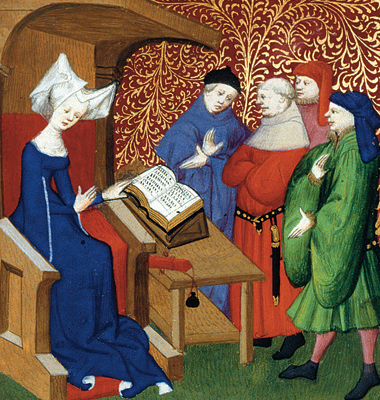
“Tis magic, magic that hath ravished me.”
Dr. Faustus by Christopher Marlowe
You must know of our Dr Faustus of the medieval times who sold his soul to the devil. Why do you think he did it? Being a scholar of divinity, he knew too much about the clergymen and their corruption! Faustus would rather sell is soul to the devil and later ask for forgiveness personally from God rather than buying pardons from the clergymen. He was a man of religion, an insider and he knew how religion was being used to make a fool out of people. If a scholar could do that, why not the poor peasants who suffered the most from a brand of religion that has been used as a tool to suppress and violated their basic rights!
As the peasants breathed the town air, their minds expanded. They started seeing and thinking. The more they tried to free themselves, the more they suffered. But they discovered more also. In the early middle ages, peasants were illiterate and only a portion of the clergymen could read and understand Bible. With the emergence of the towns and trade in the later middle ages, many started training themselves in reading as the new jobs required “writing things down”. Later, an earthshaking invention “printing machine” shook the old world to the core! Everyone could read the Bible! A common man discovered what true religion felt like- especially new testaments and the spiritual teaching of Jesus Christ. Jesus sounded more of a rebel than a clergy man when he said
‘’The rich will be poor forever”.
All these new landless peasants started running amuck in the wake of commutation. Different peasants’ groups and cults were formed: Millenarianism and the Heretical sects Millenarian movements were composed of landless peasants, prostitutes, defrocked priests, and day laborers: or as Federici calls them “the wretched of feudal society.” (31)
Lords were certainly armed in ways the peasants were not, and their power was backed by the teaching of the church. The Church was the biggest landlord itself! In many areas the bitterness flared up as never before. Peasants started challenging the old beliefs in more ways than one. First they refused to pay taxes to the church. Peasant women started denouncing the churchmen who abused them. The revolt by the wretched against the noble was a new type of struggle that reached far beyond the limits of the manor and envisioned a total change in society. Millenarianism was often accompanied by profound prophecies and apocalyptic visions. They came in many forms of organized groups of rebels. In some places, it was the cults who might have made Faustian pact with the devil, in other places, it was the people who believed in the second coming of Christ. They were mainly spontaneous movements with little organizational structure. They were usually based on specific events and/or led by charismatic leaders. As such, as soon as force was applied against them, they typically collapsed. While these movements were short-lived, they spoke to the desire for something new.
Some of these Millenarian movements include:
- In 1224, there appeared a man called Pseudo Baldwin who instigated a civil war in Flanders (Flanders is here in modern-day Belgium, btw) with the promise of Gold & silver & social reform to poor Flemish weavers, metalworkers (also known as fullers), and textile workers.
- In 1251, the Crusades of the Pastoreaux swept through Northern France burning and pillaging both the nobility and the clergy. The movement began when a mysterious Hungarian Monk known only as the Master, claimed to have been visited by the Virgin Mary. The movement of nearly 60,000 was made of young peasants and they expelled archbishops, through priests into rivers, sacked monasteries, & harrassed Jews.
- In the 1260s, the movement of Flagellants spread from Italy through several European countries. Flagellants would march through cities by the thousands, whipping themselves in penitence to God. They accused anyone who refused to join them of being in league with the devil and killed Jews and priests.
A later poem tells,
“The serfs and the peasants
Held several parliaments
They spread out this command
He who is higher, he is the enemy
And several of them made an oath
That they would never agree
To have lord or master”.
According to Federici
“It was not the millenarian movement, however, but popular heresy that best expressed the search by the medieval proletariat for a concrete alternative to feudal relations and its resistance to the growing money-economy”. (32)
By denying the higher authority and making an oath to themselves and not the church, they were declared Heretics by the church. There were, after all, many of them, who in their bitterness for the lords and the church turned their backs on the old belief.
Heretical sects were a search for an alternative to feudalism: a conscious attempt at a new society. These were where us witches gathered. We reinterpreted religious traditions away from the Church’s hegemony, guided people’s need for both spirituality and social justice, and castigated social hierarchies, private property, and the hoarding of wealth by the nobility & clergy.
As my dear sister, Federici says, “At the root of popular heresy was the belief that god no longer spoke through the clergy, because of its greed, corruption and scandalous behavior… The heretics’ challenge was primarily a political one, since to challenge the church was to confront at once the ideological pillar of feudal power, the biggest landowner in Europe, and one of the institutions most responsible for the daily exploitation of the peasantry.” (33-34)
One of the most rebellious groups were the Cathers. They rejected marriage and procreation and redefined the sexual morals. While the church saw women as Eve (the great temptress), the Cathers held a great importance to women and rejected church’s attitude towards women. They also scorned the church’s attitude towards chastity. Some of the groups as Federici says, attributed the mystical value to sexual act, even treating it like a sacrament. ( page, 36.)
Sister Federici says, “The most influential among the heretical sects, the Cathars, also stand out as unique in the history of European social movements because of their abhorrence for war (including the Crusades), their condemnation of capital punishment (which provoked the Church’s first explicit pronouncement in support of the death penalty) and their tolerance of other religions.
List of heretical movements:
- Beyond the Cathars, there were the Waldensians of Lyon in the late 12th century,
- the Brethren of the Free Spirit in the late 13th Century throughout Germany, France, Bohemia, & Northern Italy,
- the Taborites of Bohemia in the 1420s,
- The English Lollards in the late-14th century.
In many cases, whenever peasants began to revolt against their living conditions, they were labeled heretics despite having no specific religious demand. Once labeled heretics, a crusade could be created against them by the combined power of the nobility and the church.
Sexual Politics
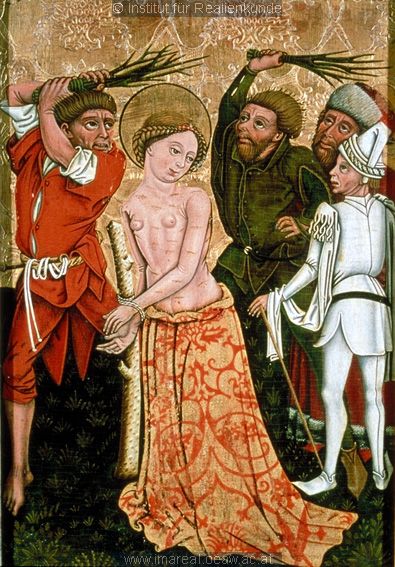
The most effective way to monitor and monopolize sexual behavior leads to women. The Church was well aware of, or rather afraid of the power that women had over man when it came to sexual desire. What was the cause of the fall of Adam? Eve! Making sexuality an object of shame was one of church’s way to avoid women and strip them of their power. Women to them, were nothing but a symbol of evil – even when they appeared in their most holy forms. Evil, according to the medieval church, resided naturally within them. Sister Federici says, “Sexuality was not a private but a state matter. If they could keep the power of one segment of the society at check by using religion as a tool, they did.”
Where there was no shame in sexuality, there was no shame in women! Here women could enjoy equal power and status. Female priests were worshipped as the Ladies of Thought. Women could preach and baptize. In these groups, men and women lived free together. Women had their own communities as well- outside male control. It was, in fact, women who gave life to the heretics’ movement. Most of them came from the most suffering sections of serfdom and peasantry. The movement even bordered on a sexual revolution when women tried to control their reproductive system. And that set the last alarm bell ringing!
These sexual doctrine of the heretical groups posed a great threat to the church that monitored sexuality. When women took charge of their own bodies and reproductive system, that symbolically shook the feudal ground to the core. So the persecution of the worst kind, as lethal and as cruel as history had hardly witnessed before, started. Women were tortured, abused and burnt alive at the stake in front of people’s eyes. There were many women who were not even part of the groups, got killed brutally. The inquisition is one of the darkest chapter of the entire world history, especially for us witches who were the harbinger of change. And the revolts were suppressed, but only for the time being.
The Black Death & Labor Crisis
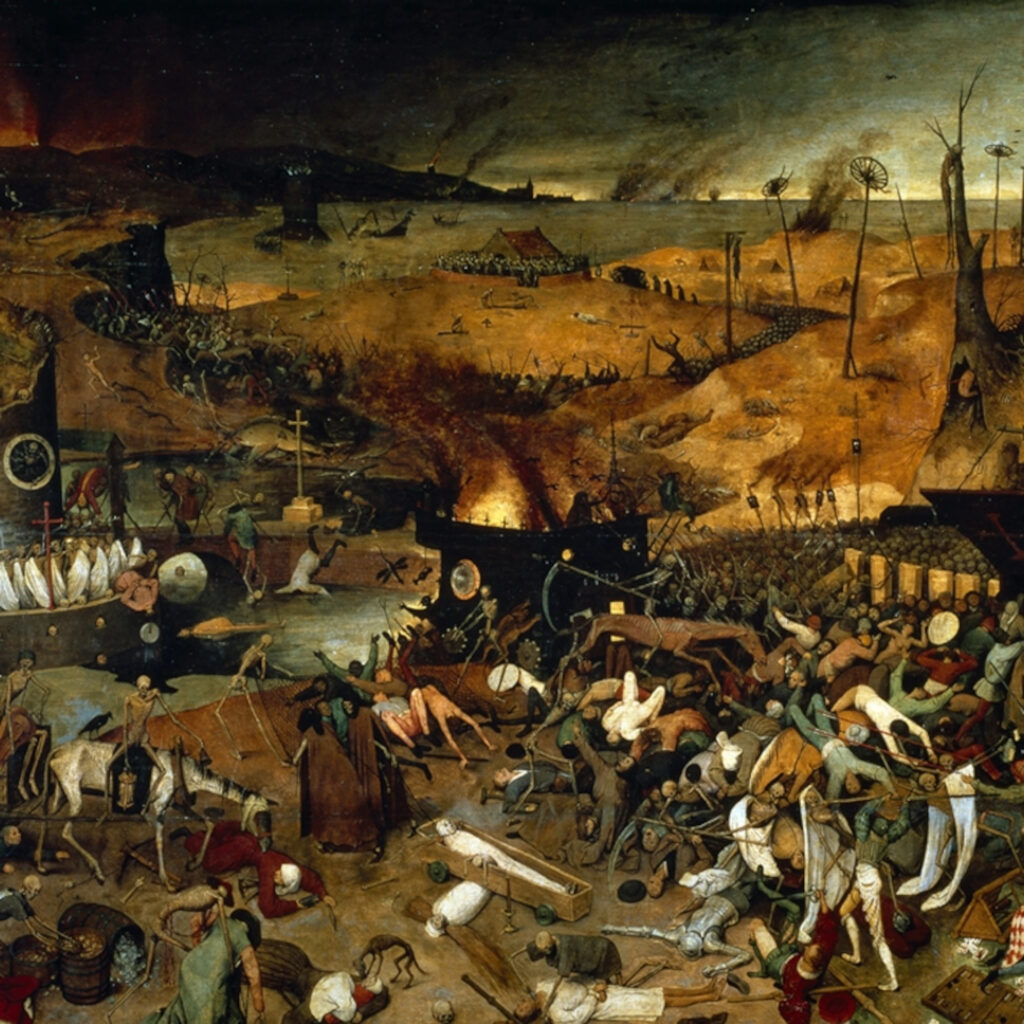
In the midst of this turmoil between the 12th-14th centuries, came the black death. Much like current times, the pandemic shifted the entire power structure. It’s devastation to society cannot be understated. Gaze upon this picture by 14th century Dutch painter PIETER BRUEGEL’S. “THE TRIUMPH OF DEATH” depicts hell on earth. It washed off more than half of the peasant population.
Those who were left, were now confronted with the uncertainly of death and didn’t give a fig to the rules of the lords. In this crisis of labor, they were now quite aware of their own labor power. The counter movements and rebellions started again. The entire villages organized themselves to stop paying taxes and fines. The counter-revolution began. And, this counter-revolution was targeted at women’s sexuality.
Throughout the medieval period, having too many children was undesirable. Therefore, various forms of birth control were used by women in an attempt to limit the children they birthed. Sterility potions or maleficia were commonly used, along with the practice of sodomy, abortion, and infanticide. After the population and labor crisis caused by the Black Death in the 14th century, the church added “reproductive crimes” to the list of heretical activities.
Federici says, “After the spread of the plague, the sexual aspects of heresy became more prominent in its persecution… Heretics were accused of animal worship including the infamous bacium sub cauda (the kiss under the tail), and indulging in orgiastic rituals, night flights, and child sacrifices.” (40)
Furthermore, to divert the young male peasants from revolution “the sex” card was used. They were granted an open sexual relation even by the Church now. This was not a real sexual freedom. Many criminals who were the penniless sons of the lords ended up raping working class and peasant women and easily got away with it. The decriminalization of rape created havoc in the world of the working class women, who after being raped had no place in the society and ended up becoming prostitutes, and later witches.
The politicization of sexuality, especially related to heretical movements, “marked the transition from the persecution of heresy to witch-hunting, and the figure of the heretic became that of a woman, so that, by the beginning of the 15th century, the main target of the persecution against heretics became the witch.” (40)
Conclusion
In this video we covered what feudalism was and how social relationships under the feudal society were formed and how many layers of exploitation it was based. How religion was used as one of the strongest weapon against people. Eventually how people rose up against it. How women suffered and how that turning point was when they took charge of their own body. How independence was seen as equivalent to black magic and how the people went through the cruelest torture ever in history and what price they paid.
No ideology has been spared in being used as a tool at the hands of the powerful classes-be it religion or even the concept of sexual freedom. In the next chapter we will discover how a new emerging power “Capitalism” used every ideology it could to exploit the working classes. In its transition to capitalism, the European society witnessed an earth-shattering bloodshed and violence against the working classes. Women suffered double degradation. First, because of their class; and second, because of their gender.
It suffered a blow when the new powerful class “Town Bourgeoisie” shook hands with another powerful class “nobility” and helped it suppress the revolution. Movements are contagious! And that’s what the powerful classes have always been scared of. The early capitalists (bourgeoisie) started getting afraid that the revolutionary wave might reach the town workers as well. Before the peasants and the worker could join hands, the nobility and the capitalists did.
“It was the urban bourgeoisie, after two centuries of struggles waged in order to gain full sovereignty within the walls of its communes, who re-instituted the power of the nobility, by voluntarily submitting to the rule of the Prince, the first step on the road to the absolute state.” (50)
